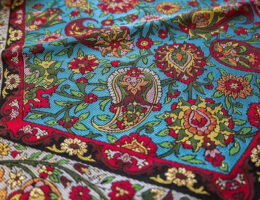IRAN ART EXHIBITION: GABBEH CARPET ARE SO IRRESISTIBLE TO BUY
The Gabbeh carpet is a typical carpet from the southern regions of Iran. Like almost all traditional carpets from Asia, its origin lies in the culture of the nomadic people who lived in the area. Unlike other Oriental carpets, Gabbeh carpets have a minimalist design that has recently been discovered by interior design enthusiasts. Let’s talk about these luxury rugs!
The characteristics of Gabbeh carpets
Like all Oriental carpets, Gabbeh carpets are made from wool and are hand-knotted by the women of the local population. The production of this type of carpet is particularly widespread in southern Iran, in the areas inhabited by the Ghasghai tribes. In contrast to the carpets that have spread to the regions of Persia, Turkey and other parts of Iran, Gabbeh carpets have a much more minimalist appearance and a coarse structure. The term Gabbeh in Farsi means something rough and natural.
Gabbeh carpets have little decoration, often stylised representations of natural elements such as plants and animals. Tribes were inspired by their surroundings when choosing decorative elements, which is why plants, animals and geometric symbols can be seen in carpets woven several centuries ago.
While Persian carpets were produced with very thin wool threads, giving the carpet a compact and rigid structure, Gabbeh carpets are made with thick wool threads, knotted either symmetrically or asymmetrically. This results in a thicker carpet and a less compact structure.
The use of thick fibres significantly reduces the processing time of carpets. Even the largest carpets can be made in a few days, while the most elaborate Persian carpets can take months to make.
IRAN ART EXHIBITION: Gabbeh carpets are therefore soft and manageable, so much so that they have traditionally also been used as blankets or mattresses. In smaller formats, Gabbeh carpets were also used as saddles or as fabrics for use inside tents.
What are the advantages of owning a Gabbeh carpet?
One of the most obvious advantages of a Gabbeh carpet is its ability to be both a decorative and functional element in the home. Strength and durability are what make Gabbeh carpets unique among Oriental carpets.
Due to the use of coarser wool fibres than those used in Persian carpets, the result is a thicker and more comfortable carpet. A Gabbeh carpet can be up to 2.5 centimetres thick and is particularly warm. Having a thick carpet in the home helps to muffle noise and is therefore particularly useful for people living in multi-storey houses.
Traditional patterns are made in bright colours, often with geometric patterns or stripes of different shades. Models made in recent years, on the other hand, tend to be made in plain colours or with very basic patterns.

Why decorate your home with a Gabbeh carpet?
Gabbeh carpets are the perfect choice for those who want to furnish their homes in a contemporary and minimalist style, but who also want to bring a little colour and warmth into their homes. You can choose between striped Gabbeh carpets with geometric patterns running across the entire surface of the carpet, or plain-coloured models with patterns distributed around the edges.
The versatility of this type of carpet means that it can be incorporated into a wide range of interior design projects. It fits perfectly in an industrial style home, for example, but also in spaces furnished in a rustic or eclectic style.
The Gabbeh carpet is perfect for all rooms where comfort and simple yet impressive designs are needed. Corridors, guest rooms and the master bedroom are all rooms that can be simply furnished with such a rug. A Gabbeh carpet is also perfect for livening up a child’s room and at the same time giving them a comfortable and warm carpet to play on. Gabbeh rugs are equally suitable for furnishing an exclusive living room, perhaps by placing the rug in front of the fireplace. During the winter months the rug will amplify the feeling of warmth in the home, while in the summer period the insulating capacity of the wool will ensure freshness.
IRAN ART EXHIBITION: Gabbeh (from the Persian language Farsi; raw, natural, uncut) represents a rough and primitive carpet with patterns mostly made by Ghashghai nomads from the Farsi province in the southwest of Iran. These carpets are probably the most well-known handmade carpets from Iran. They are manufactured by handspun wool, both in the pile and warp, and the yarns are dyed using plant dyes. The carpets are much thicker than other Persian carpets, sometimes up to 2.5 cm thick.
The patterns of the carpet are of a simple type with only a few elements of decorative, mostly rectangular objects containing animals. During the last decades, the weavers have had to meet the demands of the west and have therefore, resorted to using large light fields with chary pattering in the Gabbeh carpets.
Weavers from India have acted quickly to copy these carpets, but one must pay attention to this as there is a major difference between a Persian and a Indo Gabbeh carpet. Mostly this can be determined by the quality of the wool that is noticable, the Persian variant is much softer. The Persian variant is also much more durable and the quality is definitely better.
At present, there are different names given to Gabbeh carpets such as Basic, Amalehbaft, Kashkooli, Luribaft, Sumak and Baluch Gabbeh. A Gabbeh Kashkooli is a carpet with a higher knot density and a shorter pile than the usual Gabbeh carpets.






